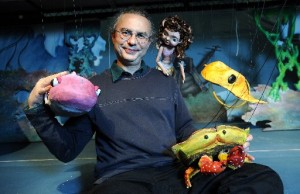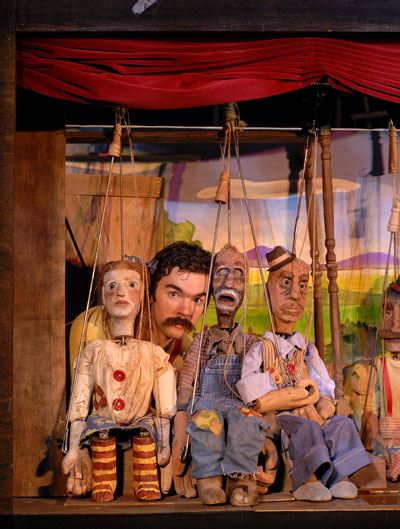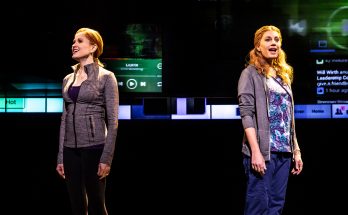
First there was “Sesame Street” and the “The Muppet Show.” Then came Broadway productions like The Lion King and Avenue Q. Now we have War Horse, a drama in which the title character is a full-scale, galloping, equine puppet named Joey. (It comes to the Fox Theatre on Sept. 25.)
Puppets, which have always had a niche in Atlanta theater, are in the spotlight again, nationally and internationally.

Atlanta puppeteer Jon Ludwig remembers seeing War Horse in London. “At a critical scene, adults in the audience were sobbing and yelling ‘No!’,” says Ludwig, artistic director at Atlanta’s Center for Puppetry Arts. “The horse captures your imagination. You know it’s not a real horse, but it has heart and character.”
That puppeteers could create such a creature didn’t surprise him. “In the puppetry world, there just aren’t that many people who say, ‘You can’t do that.’ You get to create your own world. You can push the limits. That’s what attracted me to the art form.”
The Center, where Ludwig creates stories and creatures from a basement workroom, has produced fairy tales and children’s educational theater focused on themes like space, dinosaurs, recycling and the rain forests since 1978. But it also does adult productions like “The Tales of Edgar Allan Poe,” “Frankenstein” and “Gilgamesh.” And it’s not the only game in town. As many as 60 artists focus on work with puppets in metro Atlanta.

“Puppetry is a small, fun world that is always moving forward,” says Michael Haverty, whose credits include associate artistic director at the Center and at 7 Stages as well as creator of Haverty’s Marionettes and The Object Group. “Puppeteers,” he says, “are excited to exchange ideas, and that makes us all better.”
Haverty loves that puppetry combines all the arts – visual art, dance, music and acting, with tremendous technical knowledge and physical stamina. “Puppeteers have to be able to speak and sing while scrunched over on little stools behind the set, or while leaning over a marionette bridge manipulating the weight of puppets 16 feet below. I love the challenge of that.”
He started his career as a playwright but tired of waiting for producers and actors to bring his work to life. “In the puppetry arts, I discovered I could build my own actors and set, and use everything I’ve ever learned about theater. It’s become a passion.”

A puppet production starts with an idea — a new story or an adaptation of a literary work. “The first question is, why puppets? How could puppetry make this better?” Haverty asks. He thought hand-carved wooden puppets could represent the phantasmagorical qualities of William Faulkner’s “As I Lay Dying,” for example, better than real actors when Haverty Marionettes took on the project.
Once you’ve said ‘yes’ to puppets, you must decide what kind,” he says. There are marionettes, hand, rod, shadow, toy and body puppets. Each has unique properties. “Marionettes are better at dancing and flying but not good at fighting. Shadow puppets are great when you want to portray something absolutely ridiculous, like a giant squid attacking a boat.”
The scriptwriting, puppet making, set building, music, choreography and technical details require the collaboration of many artists. It can take a year or more to get to rehearsals — and the changes that come with them. “Puppets never move exactly as expected, and they often do more than you thought they could,” Haverty says.
“The puppet is a dead thing that must be brought to life,” Ludwig says. “The puppeteer uses manipulation, gesture, body language and voice to give it breath and character. The greatest challenge is to give it heart. If the audience doesn’t care about the character, then what’s the point?”
If a puppet has character, say Kermit or Joey, then the audience will fill in the blanks of emotion. “The audience is the last member of the puppet company,” Ludwig says. “You invite them to join in and do their part. When they connect and believe and the puppet begins to respond to them — it’s an incredible moment.”
::
Laura Raines is an Atlanta freelance writer who specializes in writing about health care, education, business and the arts.




Such a lovely article about something that has been very important for our City. Jon Ludwig is one of our City’s major hidden treasures. His work has been consistently at a high level, challenging us for decades. I’m so thankful he was not seduced away to greater pastures. And MIchael Haverty, as the sort of new puppet kid on the block, is about to have his turn as a major artist in the Nation. Remarkable that we have these two artists, that Vince Anthony laid the groundwork for Atlanta being the only city in the country with a major Center for Puppetry. We are indeed fortunate. People should go over to Spring Street and see some of this fabulous puppetry: take the family, send the kids, demand the schools go there.